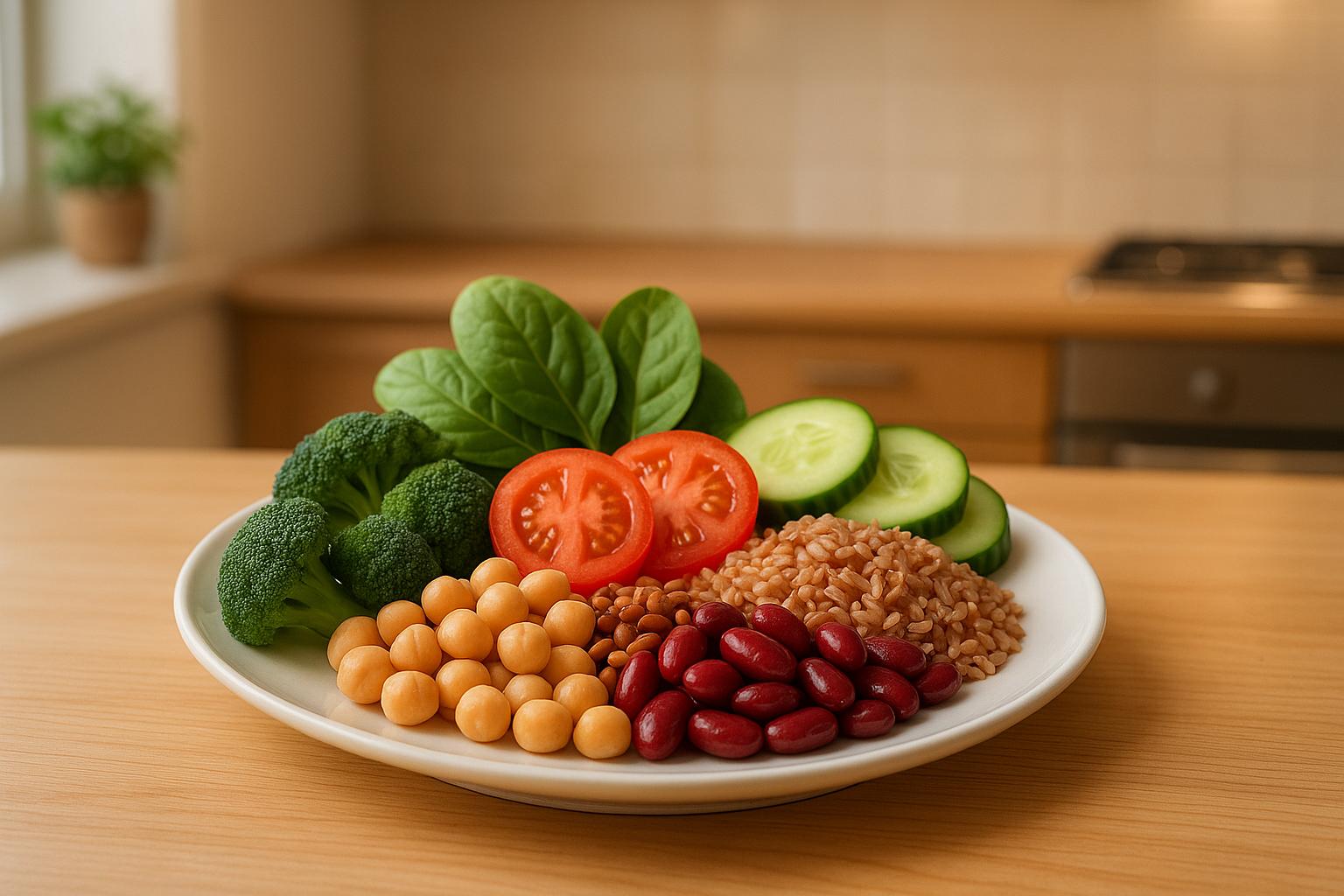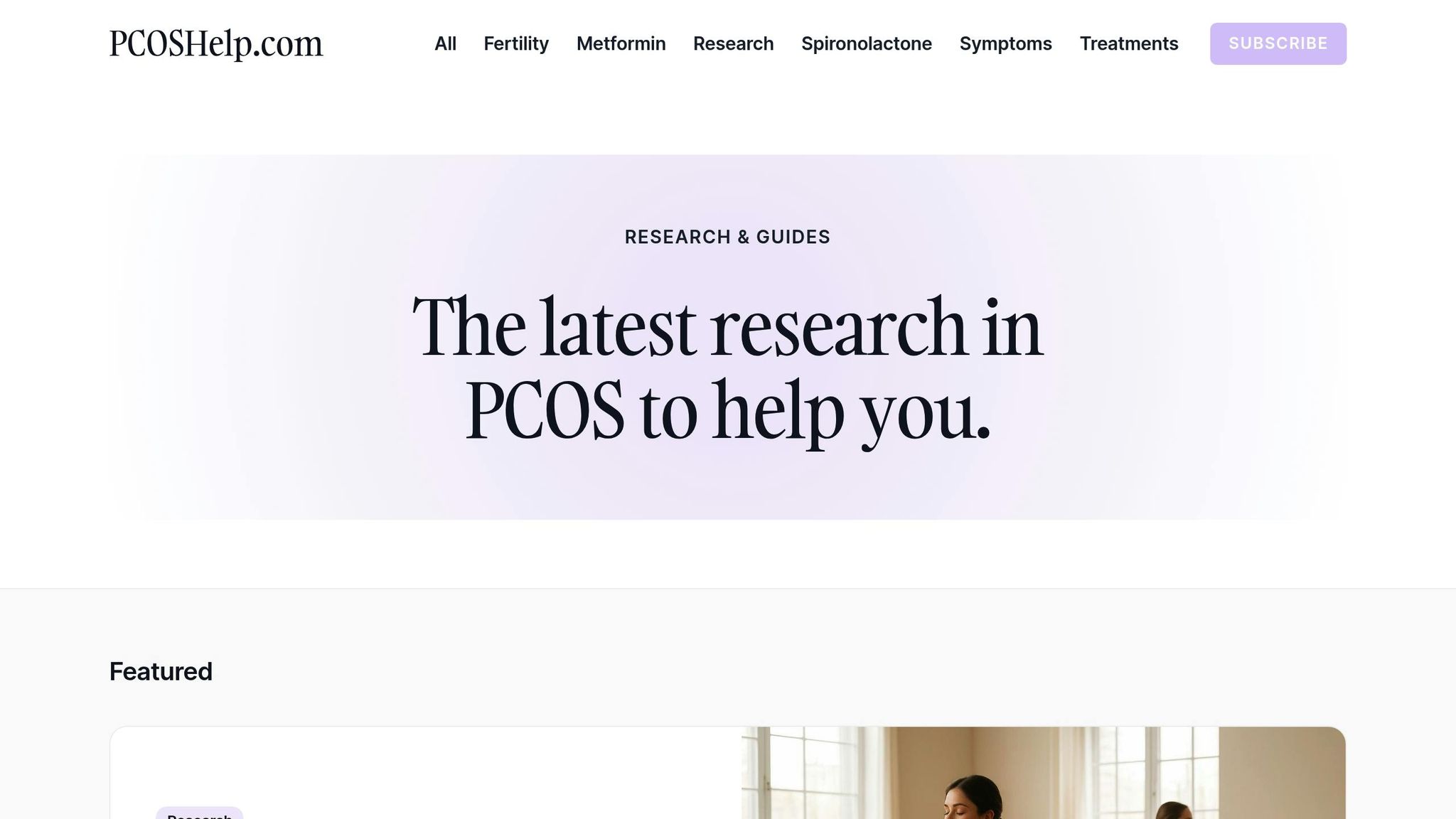How Glycemic Index Affects Endometrial Function
Learn how low-glycemic index foods can enhance endometrial health and support reproductive function, especially for those with PCOS.

Learn how low-glycemic index foods can enhance endometrial health and support reproductive function, especially for those with PCOS.

Your diet directly impacts your endometrial health, especially if you have PCOS. Managing blood sugar through low-glycemic index (GI) foods can improve menstrual regularity, hormone balance, and fertility. High-GI foods lead to insulin spikes, which disrupt hormonal balance and endometrial function. Low-GI diets, on the other hand, stabilize blood sugar, reduce inflammation, and support healthier ovulation.
Making small, consistent changes to your diet can significantly improve your reproductive health. If symptoms persist, consult a healthcare provider or dietitian for personalized advice.

Expanding on the link between blood sugar levels and endometrial health, let’s delve into how the glycemic index (GI) plays a role in reproductive function. The GI of foods can trigger biochemical shifts that influence fertility, particularly by impacting menstrual cycles and overall reproductive outcomes.
High-GI foods - think instant rice or sugary snacks - cause rapid spikes in blood sugar followed by surges in insulin. Over time, this can reduce insulin sensitivity. For women with PCOS, who are already more susceptible to insulin resistance, these effects can be even more pronounced.
Elevated insulin levels can lead to increased ovarian androgen production and a reduction in sex hormone-binding globulin (SHBG). This hormonal imbalance disrupts the endometrial environment, interfering with its ability to function properly.
When insulin resistance develops, it sets off a chain reaction of metabolic changes that impair the endometrium’s ability to respond and prepare for implantation. Disruptions in estrogen and progesterone signaling can lead to uneven endometrial thickening, which may hinder implantation.
These irregularities can also manifest as unpredictable menstrual cycles or heavier-than-normal bleeding, further complicating reproductive health.
Studies have examined how dietary glycemic load influences endometrial function, particularly in women with PCOS. High-GI diets have been linked to poorer reproductive outcomes, while low-GI diets have shown improvements in menstrual regularity and endometrial receptivity. This aligns with earlier findings about the hormonal imbalances caused by high-GI foods.
Adopting a long-term approach to nutrition that prioritizes low-GI foods may help manage insulin resistance and promote better reproductive health. As research in this area grows, tailored dietary strategies continue to be an important piece of the puzzle.
Building on the connection between glycemic index (GI), blood sugar, and endometrial health, making smart dietary adjustments can significantly improve reproductive well-being. Choosing the right foods can help stabilize blood sugar levels and support a healthy endometrium.
Low-GI diets are a game-changer when it comes to managing blood sugar and hormonal balance. By avoiding sharp insulin spikes, these diets improve insulin sensitivity and reduce excess insulin production. For women with PCOS, this often means lower androgen levels and better regulation of sex hormone-binding globulin (SHBG).
Another key advantage is the reduction of inflammation. Chronic inflammation can hinder the endometrium’s ability to respond to hormonal cues and thicken properly. Low-GI eating helps lower inflammatory markers, creating a healthier environment for the endometrium to function as it should.
Many women report more regular menstrual cycles within three to six months of following a low-GI diet. Stable blood sugar levels help smooth out hormonal fluctuations, leading to more consistent ovulation and better preparation of the endometrium.
Incorporating low-GI foods into your meals doesn’t have to be complicated. Start by replacing high-GI items with healthier alternatives and focus on whole, minimally processed options.
Anchor your meals with protein and healthy fats, which slow down glucose absorption. Foods like eggs, chicken, fish, nuts, seeds, and avocados are excellent choices - they’re not only easy on blood sugar but also packed with nutrients essential for hormone production.
Opt for complex carbohydrates over simple ones. For example, choose steel-cut oats instead of instant oatmeal, brown rice instead of white rice, and sweet potatoes instead of regular potatoes. The higher fiber content in these options slows digestion and helps prevent blood sugar spikes.
Pair complex carbs with proteins or healthy fats for balanced meals. If you’re consuming higher-GI foods, aim to eat them earlier in the day when your body is better equipped to manage glucose levels. Portion control is also key - use the plate method: fill half your plate with non-starchy vegetables, a quarter with lean protein, and the remaining quarter with complex carbs.
Knowing which foods to limit and what to eat instead makes adopting a low-GI diet much easier. The goal isn’t to be perfect - it’s about making better daily choices that support your endometrial health.
| Foods to Limit | Low-GI Alternatives | Why the Swap Helps |
|---|---|---|
| White bread, bagels | Ezekiel bread, sourdough | Higher fiber content slows glucose absorption |
| Instant oatmeal | Steel-cut oats, overnight oats | Less processing preserves fiber structure |
| White rice | Brown rice, quinoa, cauliflower rice | More fiber and nutrients, slower digestion |
| Regular pasta | Whole grain pasta, shirataki noodles | Lower glycemic impact, better satiety |
| Sugary cereals | Greek yogurt with berries | Protein helps stabilize blood sugar |
| Fruit juices | Whole fruits with skin | Fiber slows sugar absorption |
Refined sugars and processed snacks like candy, cookies, and sugary drinks are best avoided. These cause rapid blood sugar spikes, which can disrupt insulin sensitivity. If you’re craving something sweet, fresh berries are a great alternative - they’re naturally sweet and come with the added benefits of fiber and antioxidants.
When it comes to starchy vegetables, portion size matters. For example, small servings of red potatoes with the skin on provide more fiber compared to large portions of peeled russet potatoes. Sweet potatoes are another excellent choice, offering a lower GI and additional nutrients that promote hormonal balance.
Processed breakfast foods often pack hidden sugars and refined grains, leading to a blood sugar spike first thing in the morning. Instead of instant oatmeal or sugary cereals, try overnight oats with chia seeds or a protein-rich breakfast like eggs with sautéed vegetables.
When dining out, stick to grilled proteins and vegetables, and ask for dressings or sauces on the side to avoid hidden sugars and refined starches. These simple adjustments can help keep your blood sugar steady.
Making gradual changes is the key to success. Start by swapping out one high-GI food per week for a lower-GI option. This slow transition allows your taste buds to adapt and makes the process less overwhelming. For more tips and meal planning resources, PCOSHelp offers valuable guidance to support your journey toward better endometrial health through nutrition.
Making dietary changes is a great step toward supporting endometrial health, but keeping an eye on your progress and knowing when to seek professional advice are just as important for maintaining reproductive health.
Once you've started following a low-glycemic index (low-GI) diet, tracking your menstrual patterns and symptoms can help you measure progress. Keep a menstrual diary to log the start and end dates of your periods, note the flow intensity, and document symptoms like cramping or mood swings. Over time, you might notice improvements in cycle regularity and symptom relief as your diet helps stabilize blood sugar levels.
If you're trying to conceive or want a better understanding of your cycle, pay attention to ovulation signs like changes in cervical mucus, shifts in basal body temperature, or mild ovulation-related discomfort. Many women with PCOS report more consistent ovulation after improving their blood sugar control.
Beyond your cycle, monitor other physical and emotional changes. Energy levels, mood, acne, hair growth, weight, and sleep quality can all reflect hormonal balance. Whether you prefer using a smartphone app or a simple calendar, consistent tracking can help you recognize patterns and decide when it’s time to reach out for professional help.
While dietary changes can lead to noticeable improvements, some symptoms require medical attention. Contact your healthcare provider if you experience unusual bleeding, such as spotting between periods, heavy bleeding, or postmenopausal bleeding.
Significant menstrual changes, like cycles shorter than 21 days or the complete absence of periods, should also be evaluated. Abnormal vaginal discharge or bleeding after sex are additional signs that need professional assessment.
Persistent lower abdominal or pelvic pain, severe cramps, or discomfort during intercourse should not be ignored. Similarly, if you notice pain during bowel movements, changes in bowel or bladder habits, or painful urination with blood, it's important to seek medical advice.
If you're struggling to conceive after six months of trying - or three months if you're over 35 - it’s a good idea to consult a fertility specialist. Conditions like endometriosis often only become apparent during fertility evaluations. Other concerning symptoms, such as ongoing bloating, abdominal swelling, unexplained fevers, or a general sense of illness, also warrant a conversation with your doctor.
Trust your instincts. If something feels wrong, don’t hesitate to discuss it with a healthcare professional. You might also consider working with a registered dietitian who specializes in PCOS and reproductive health. They can help you create a personalized low-GI meal plan to support your hormonal health.

In addition to professional guidance, reliable online resources can provide valuable support. Managing PCOS and endometrial health can feel daunting, but platforms like PCOSHelp offer research-backed information to help you navigate these challenges.
PCOSHelp provides evidence-based advice on fertility, medications, and symptom management to complement dietary changes. For example, you can learn about medications like Metformin, which may improve insulin sensitivity, and get tips on managing any side effects.
The site also addresses stress and mood management, which are key to maintaining hormonal balance. Chronic stress can undermine the progress you make with dietary adjustments, so having effective stress management strategies is crucial.
PCOSHelp’s resources can also help you differentiate between normal recovery processes and symptoms that require medical attention. This empowers you to make informed decisions about your care and communicate effectively with your healthcare team.
Your food choices play a key role in shaping your endometrial and overall reproductive health. Understanding how the glycemic index (GI) impacts endometrial function gives you practical ways to support your reproductive system, especially if you’re managing PCOS. The link between blood sugar levels, insulin resistance, and endometrial health isn’t just theoretical - it can lead to real improvements in your menstrual cycle and overall well-being.
Opting for low-GI foods instead of high-GI options helps stabilize blood sugar levels and minimizes insulin spikes that could disrupt hormonal balance. This adjustment can promote more regular periods, healthier ovulation, and better endometrial health over time. Research shows that low-GI diets have helped many women with PCOS improve their reproductive function. Even small, consistent changes - like swapping refined grains for whole grains - can make a noticeable difference without requiring a complete lifestyle overhaul.
Keep track of your progress using the methods discussed earlier, and if symptoms persist, don’t hesitate to seek guidance from a healthcare professional.
A low-glycemic index (GI) diet can be a game-changer for women with PCOS, particularly when it comes to improving endometrial health. By boosting insulin sensitivity and keeping insulin levels in check - two common challenges in PCOS - this approach helps balance hormones, encouraging healthier endometrial function and more consistent menstrual cycles.
Keeping blood sugar levels stable with a low-GI diet can also reduce the chances of developing endometrial hyperplasia, a condition where the uterine lining thickens excessively. This not only supports reproductive health but may also lower the risk of serious issues like endometrial cancer.
Adding more low-GI foods to your meals - think whole grains, legumes, vegetables, and lean proteins - can make a noticeable difference in managing PCOS symptoms while promoting long-term endometrial health.
Incorporating low-GI foods into your meals doesn’t have to be complicated. Start small by adding more non-starchy vegetables like broccoli, spinach, and carrots. These are naturally low-GI and work perfectly in salads, stir-fries, or as simple side dishes. Another easy swap is replacing refined grains with whole grains - think brown rice, quinoa, or whole wheat bread. When it comes to fruit, go for options like apples, berries, or pears instead of higher-GI choices like pineapple or watermelon.
You can also balance things out by pairing higher-GI foods with protein or healthy fats. For example, add avocado to your toast or enjoy a handful of nuts alongside your fruit. These minor tweaks can help keep your blood sugar levels steady while improving your diet without the need for a drastic change.
Switching to a low-glycemic index (low-GI) diet can have a noticeable impact on your menstrual cycle and overall endometrial health. You might observe changes like more predictable menstrual cycles, less discomfort during your period, and consistent cycle lengths. Additionally, symptoms of hormonal imbalance - such as intense premenstrual symptoms or irregular bleeding - may become less frequent or severe.
These improvements often reflect better hormonal balance and healthier endometrial function. This is tied to the way a low-GI diet helps stabilize blood sugar levels and boosts insulin sensitivity. Keeping an eye on these changes can give you a clearer picture of how your dietary choices are supporting your health.